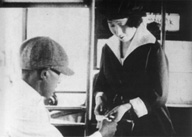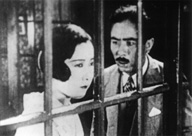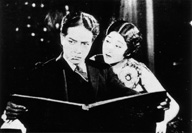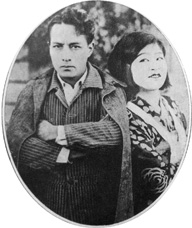| Films about Yamagata |
|---|
|
|
Part 3 Yamagata Venusography
We begin with Tatsuta Shizue (1903–1962), born in Kanakame in Kaminoyama City, Yamagata. Aspiring to be a photographer, she dropped out of Japan Women’s University. Later, deciding to become an actress, she was favored by director Shimazu Yasujiro, and appeared in quite a number of his movies, including A Modern Temperament (1927) and Landscape of Love (1929). She was popular as an early “modern girl,” and also appeared in films directed by Gosho Heinosuke (A New Kind of Woman, 1929, and others), Toyoda Shiro (Painted Lips, 1929), Saito Torajiro (Love Me, Please, 1929, and others), and Naruse Mikio (Love Is Strength, 1930), although very few of her films have survived. After retiring she opened a successful bar in Ginza. Tatsuta passed away in 1962.
And then there is Sato Chiyako (1897–1968). Born in Yamagata’s Tendo City, her talent was discovered by a preacher in a church there and she set her sights on music. She made her recording debut after cultivating relationships with Nakayama Shinpei, Noguchi Ujo, and others; with her hit “The Port of Habu” and the following year’s “Tokyo March,” she became the first popular recording artist in Japan. Both films showing in this year’s festival were originally made to capitalize on the popularity of these hits, although Sato Chiyako herself didn’t appear in them. She had already left for Italy to study opera—and as a means of settling her romantic relationship with Nakayama Shinpei, it has been suggested. Nonetheless, after returning home, there was no return of her former fame, and her later years were said to be lonely ones.
—Tomitsuka Masaki
 Vanity Is Hell
Vanity Is Hell
(“Kyoei wa jigoku”)- 1925 / Silent / B&W / 16mm (Original: 35mm) / 15 min
Director: Uchida Tomu
Photography: Hayakawa Kiyoshi
Cast: Tatsuta Shizue, Hasegawa Kiyoshi
Production Company: Asahi Kinema
Source: Matsuda Film Productions
A rare Uchida Tomu comedy, his first narrative film and so well-loved that it sold around a hundred prints. Tatsuta Shizue plays the “modern girl” to the hilt. Shoeshiner Haruo and “bus girl” Natsuko are leading a sweet newly-married life. Haruo posed as an elite salaryman for a big company in order to win Natsuko’s heart because Natsuko, for her part, has been purporting to be a company president’s secretary. One day when Natsuko sees him shining shoes, his heart is broken and he plans to kill himself. He tries to throw himself under a bus, and the one who comes off the bus in surprise is Natsuko . . .
 My Sin: Sakubei’s Story
My Sin: Sakubei’s Story
(“Ono ga tsumi Sakubei”)- 1930 / Silent with Japanese narration / B&W / 16mm (Original: 35mm) / 21 min
Director: Sasaki Tsunejiro
Original Story: Kikuchi Yuho
Script: Yanai Takao
Photography: Inokai Suketaro
Cast: Inoue Masao, Tatsuta Shizue, Takeda Haruo, Komura Shinichiro, Nara Shinyo, Sugawara Hideo, Yamakawa Masao, Tsukioka Hatsuko, Matsui Junko
Production: Shochiku Kinema
Source: Matsuda Film Productions
Based on Kikuchi Yuho’s best-known work, which has been credited with establishing the newspaper-serial novel. One of the three great Shinpa tragedies, My Sin has been filmed over twenty times. In the original, Tatsuta Shizue’s character Tamaki is the main character, but in this film, the focus turns to Sakubei.
Tamaki was in love with a doctor named Tsukaguchi, but he leaves her when she becomes pregnant. She tries to kill herself but is saved by Sakubei, a fisherman. He ends up raising her child at the request of her father, whereupon Tamaki marries into the family of Viscount Sakurado . . .
 Tokyo March
Tokyo March
(“Tokyo koshinkyoku”)- 1929 / Silent with Japanese narration / B&W / 16mm (Original: 35mm) / 24 min (abridged version)
Director: Mizoguchi Kenji
Original Story: Kikuchi Kan
Script: Kimura Chiio
Photography: Matsuzawa Matao, Yokota Tatsuyuki
Cast: Natsukawa Shizue, Kazuki Reiji, Takagi Eiji, Kosugi Isamu, Irie Takako, Sakuma Taeko, Takihana Hisako
Production Company: Nikkatsu
Source: Matsuda Film Productions
A Mizoguchi film named for Chiyako’s hit song, from the original novel by Kikuchi Kan. The radio version Mizoguchi directed was also a huge hit. Originally a ten-reel, full-length film, today only this short version remains. The performances of Natsukawa Shizue as Michiyo and Kosugi Isamu as Sakuma attracted attention.
Fujimoto Yoshiki, the son of a wealthy man, falls in love at first sight with Michiyo, the daughter of a dead geisha. However, when Michiyo’s uncle goes bankrupt, she must became a geisha herself to help him. Michiyo and Yoshiki meet again at a dinner party and he proposes marriage, but it turns out that Michiyo is in fact Yoshiki’s father’s daughter by a different mother . . .
 The Port of Habu
The Port of Habu
(“Habu no minato”)- 1929 / Silent / B&W / 16mm (Original: 35mm) / 34 min
Director: Nezu Arata
Original Story, Script: Tsukuda Kesshu
Photography: Hirano Yoshimi
Cast: Utagawa Ruriko, Azuma Chiyoko, Takada Minoru, Sumiyoshi Emiko
Production Company: Toa Kinema
Source: Matsuda Film Productions
Also based on a song of Chiyako’s, “The Port of Habu,” considered to be the first record commercially sold in Japan. Star Utagawa Ruriko was once the poet Sato Hachiro’s wife.
Kaoru, unable to bear the pain of a broken heart, comes to Tokyo from her home in Oshima and becomes the “queen” of Café Brandy. Her customer Takai, whom she fancies, hates “modern girls,” not that Kaoru has completely turned into one. One day Kaoru’s penniless little sister Omitsu comes to visit. And who should help her out but Takai . . .
